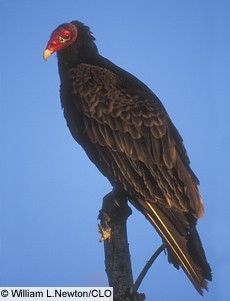Species of the Week: Turkey Vulture
Why turkey vulture as the species of the week? Why not!
I happen to think Cathartes aura is one of the most underappreciated of our native birds. So what if they eat carrion (i.e., dead stuff), defecate on their own legs to cool themselves, and vomit on an approaching human or predator as a means of self-defense? They are undeniably one of the most beautiful species "on the wing." And they have a certain charm that I just can't resist.
Image

Turkey vultures have a wingspan of 5-6 feet. They are easily identified in flight by their distinctive dihedral (v-shape) wing position and their very infrequent flapping. Vultures rely on rising currents of warm air, known as thermals, which help them achieve lift. By "riding" the thermals, they can fly without much flapping of their wings.
Closely related to black vultures, which can also be found locally, the turkey vulture is distinguished by its bright red, bald head.